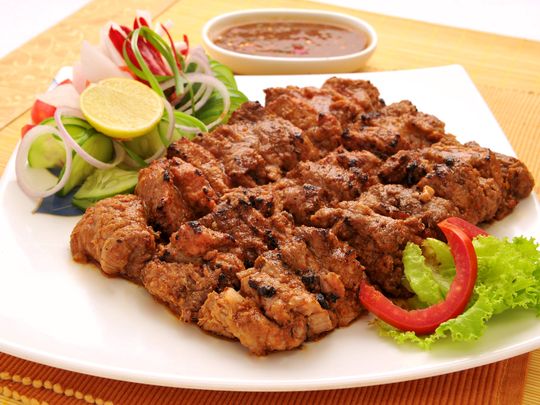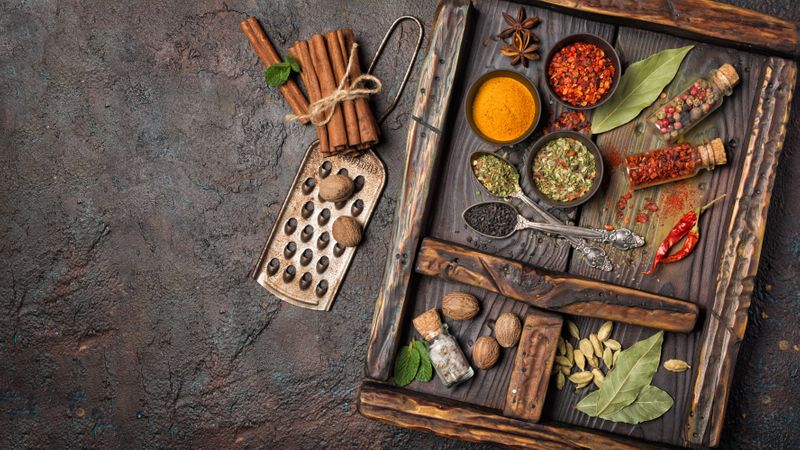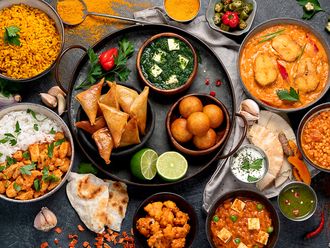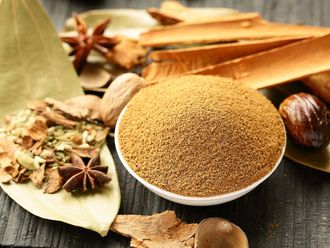
A piece of crispy poori paratha (fried bread), topped with a chunk of smoky Bihari Kabab with some freshly-cut raw onion rings – many food lovers would say there’s little that matches the bliss of such a mouthful.
Whether you’re sitting on a plastic chair at a busy roadside eatery in Karachi or enjoying the delicacy at home, the spicy, smoky, Bihari kabab, also called Bihari boti, is a must-try in Pakistani cuisine.
The sizzle of the fat and mustard oil dripping onto the coals, when it’s brushed on the meat cubes, is a sound known to most Pakistani food enthusiasts.
What makes Bihari kababs special?
The dish usually consists of pieces of beef marinated in a mix of spices, often a blend of around 30, for 48 hours and then cooked on skewers over flaming hot coals. Unlike many other kabab recipes, which require minced meat, well-cut pieces of meat, usually beef tenderloin, are the star of the show in this dish. Bihari kabab is spicier as compared to other kababs like gola or seekh kabab.
However, they stand out because of the smoky flavour, which barbecue dishes distinctly have from cooking over coals.
The result is a zesty bite that leaves eaters sniffling and grabbing lime-flavoured sodas, which are usually drunk while having the dish.
Speaking to Gulf News Food team, Natasha Qizilbash, Pakistan-based food blogger and cookbook author, talked about what she loves most about the dish. She said: "The first thing that comes to my mind as I speak about Bihari kabab is its soft, almost melt-in-the-mouth texture."

"The first thing that comes to my mind as I speak about Bihari kabab is its soft, almost melt-in-the-mouth texture."
Qizilbash added: "Recipes for Bihari kababs use raw papaya as tenderiser and a spice mix as the marinade, called Bihari kabab masala (spice mix). After that, these kababs are skewered and grilled on an open fire (or over coal), which lends the charred flavour. You can simply pair them with parathas (shallow fried bread) or even bread toast.”
Imroze Nasim Khan, a 37-year-old entrepreneur and food enthusiast from Karachi, based in the UAE, spends a lot of time recreating recipes from her hometown. For Khan, each spice in Bihari kabab plays an important role in creating the perfect harmony of flavours.

With every bite, you will feel a rich, complex burst of flavours in your mouth.
She said: "There are different types of kababs in different cuisines, just like you have so many kinds of biryanis, but the flavour makes Bihari kababs stand out. It is predominantly spicy but not overwhelming. With every bite, you will feel a rich, complex burst of flavours in your mouth."
Another critical factor in making the dish, according to Khan, is how these spicy kababs are marinated. "They are marinated with spices and in mustard oil for a unique flavour,” she said.

A plate of Bihari kababs is a must at gatherings
Khan usually cooks for her friends and family in the UAE, and Bihari kababs are a must at her food gatherings. On days when she is running short on time to marinate the kababs for longer hours, Khan shares a cooking tip that has been helping her over the years. "Add salt towards the end of marination time if you are marinating for an hour or less and if you have time to keep the marinade on longer, add the salt in the beginning."
Khan shared how she uses sensory cooking while making her version of the kababs: "I marinate with clean bare hands and avoid wearing gloves. I've heard the body heat transferred from our hands onto the meat and spices helps with the marination and makes the cooking process more engaging, and you can also feel the texture of the meat properly."
Besides gatherings at home, the delicacy is important to any Pakistani wedding menu, especially during a Mehndi or henna ceremony, where dishes like kababs and chicken tikkas paired with parathas are usually served. The hearty curries and rice-based dishes are reserved for the main events like the baraat (wedding ceremony) and reception dinner.
Guests rolling into the venue to loud wedding-themed music, dhol or drum players and dancers, and of course, watching rows of barbecue masters skilfully fanning these kababs is a definite sight at a Pakistani Mehndi. The strong aroma of Bihari kababs in the air at such events sets the ambience.
A slice of history
Khan talked about the origin of the dish. "Like the name suggests, these kababs are from Bihar, but today they are more popular in Pakistan, Karachi to be specific. You can make them with chicken and mutton, but the authentic Bihari kabab recipe uses beef. Unlike other kababs, Bihari kababs emphasise meat cuts; the undercut or tenderloin (thin strips) are called pasanday, regionally. The meat cut is what differentiates Bihari kababs from the other kinds."
Kababs known in the Middle East, are believed to have Turkish origin. A period during the Ottoman Empire (1301-1922) that ferried the popular meat format to the Mediterranean Rim, North Africa, and Greece according to an article – ‘A Brief History of Meat-on-a-Stick’ published by ny.eater.com. Many food historians also believe kabab to be a war food, where soldiers would roast meat chunks, skewering them on sword edges.
Later, Kababs reached the South Asian sub-continent with the Mughal invaders (1526–1761). Soon, different varieties of kababs like gola, seekh, chicken boti and more became a part of South Asian kitchens. One such variety is the Bihari kababs. As the name suggests, they were a speciality of the Muslim community that belonged to Bihar, a state in the East of India. Some people from the Bihari community migrated to Pakistan in the first half of the last century, according to an article titled ‘Bihari Kabab Recipe Here's How You Can Make This Delicious Dish At Home’ by republicworld.com.
Dish that reminds many of home
While many in Pakistan enjoy the dish, those who have travelled across the world have brought their recipe of making these kababs along with them.

Sikandar Ali, general manager of Daily Express Pakistani restaurant, in Dubai, uses a mix of 31 hand-picked whole spices, which he imports from a spice market in Karachi’s famous Sadar Bazaar. A practice he has been following for the last 12 years since he moved to the UAE.
Ali even shared some of the unique ingredients he uses. The marinade he adds to the meat includes orange juice and rose petals.
According to Ali, a good kabab masala recipe and marination technique is the key to perfecting Bihari kababs.
It can be made using the tender cuts of chicken, mutton or beef. Ali added: “If you are using chicken then the ideal time to marinate is 24 hours and for tougher meats like beef, I would say 48 hours is good. This allows the masalas (spices) to be absorbed in the meat and make the kababs very soft."

"Bihari kababs are one of our most in-demand food dishes, our specialty."
At his restaurant, Bihari kababs are usually prepared in bulk, around 5 kilograms at a time because they are one of the most ordered kabab dishes. Ali said: "Bihari kababs are one of our most in-demand food dishes, our specialty."
Ali spent his childhood in Karachi, his hometown, and is well versed in regional flavours especially of Bihari kababs that are a popular delicacy in his hometown. His well-acquainted taste, years of research, and finally arriving at the perfect recipe for these succulent kababs is a labour of hard work. "I was born in Karachi and grew up eating the food, especially street food along Burns Road, a street well known for its eateries. I learned much about Bihari kababs by eating them regularly at these food spots. When I was looking to create the Bihari kababs recipe for our restaurant, we scouted the spice markets in Karachi, handpicked them, and tried them.”
If you also want to be teleported to the busy street eateries of Karachi and try out the dish, here’s an authentic recipe shared by Qizilbash. She suggests using a store brought Bihari kabab masala mix. She uses them in her recipes too.
Ingredients:
1kg beef (small cubes) or minced beef
2 tbsp each ginger and ginger paste (equal portions)
2 cups beaten unsweetened yoghurt
2 onions thinly sliced, fried and crushed
1 cup raw papaya skin on and blended to a paste
4 tbsp oil (2 tbsp preferably mustard oil included)
50 gms Bihari Kabab masala powder can be store bought
Method:
1. Marinate the beef with ginger-garlic paste, yoghurt, onions, papaya paste, and Bihari kabab masala. Keep it aside for 6 hours or overnight in a refrigerator.
2. Then, heat 4 tbsp oil in a pan. Add the marinated meat, and cook on medium heat till the liquid dries out. Slow fry until the oil is released. Ensure it’s cooked, or add water and cook more till the liquid dries out.
Infuse it with coal smoke towards the end. To do this, heat a piece of charcoal, the cube-shaped ones, then carefully place it in a bowl. Pour a tablespoon of ghee or clarified butter on top of it. This will start generating smoke, lending food the smoky charred flavour. Quickly and carefully place the bowl in the centre of the kabab plate and cover it with a lid. Let the smoke infuse for 15 minutes.
If you are using a charcoal grill, you can thread the kabab onto skewers and grill them. Keep turning over the skewers often so that all sides are grilled well.
Serve with hot roti, naan or paratha and enjoy!
















